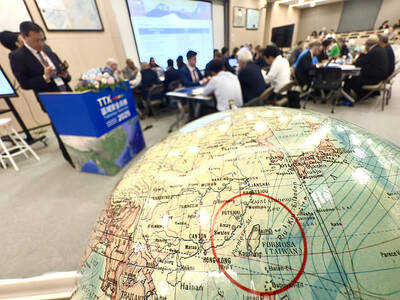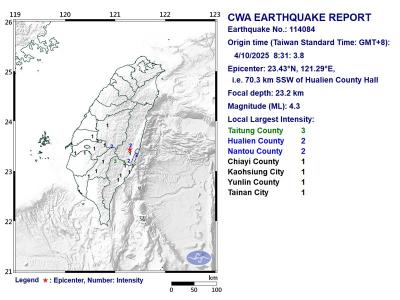China has been increasing cyberattacks, military exercises and ‘gray zone’ tactics against Taiwan in a combined effort to pressure the nation and deplete its resources, National Security Bureau (NSB) said today in a report to the Legislative Yuan.
The NSB submitted a written report to the Legislative Yuan today in preparation for NSB Director-General Tsai Ming-yen's (蔡明彥) meeting with the Foreign Affairs and National Defense Committee tomorrow.
Last year, the Chinese People’s Liberation Army (PLA) conducted the “Joint sword-2024A and B” military exercises around Taiwan and carried out 40 combat readiness patrols, the NSB said.

Photo: Tien Yu-hua, Taipei Times
In addition, Chinese military aircraft entered Taiwan airspace 3,070 times last year, up nearly 80 percent from 1,703 times in 2023, it said.
On March 17 this year, the PLA conducted two combat readiness patrols in a single day for the first time, the bureau said.
The PLA launched successive military exercises last Tuesday and Wednesday, amplifying psychological and military pressure against Taiwan, it added.
The bureau also pointed out that China is continuing to diversify its gray zone tactics, including expanding the use of drones to conduct surveillance around Taiwan.
China has also increased its use of weather balloons, the NSB said, releasing 76 so far this year as of March 19, compared with 147 throughout last year.
These balloons force Taiwan to dispatch monitoring forces, taking up responsive resources and undermining external communication resilience, it said.
The NSB intends to increase communication and intelligence cooperation with international partners and enhance its strategic analysis capabilities to strengthen Taiwan’s defenses against China, it said.
Regarding cognitive warfare, intelligence agents have recorded 510,000 instances of “controversial information” spread online by China so far this year, the bureau said.
China has been using state-run media, privately-run accounts, cyber-army groups and PR firms to manipulate public opinion, the NSB said.
China uses cognitive warfare to divide Taiwanese society by commenting on controversial issues such as the Taiwan Semiconductor Manufacturing Co’s (TSMC, 台積電) plans and operations in the US, it said.
Disinformation was found on online forums such as PTT and Dcard, plus social media platforms X and TikTok, though the majority were on Facebook, it said.
In addition, around 3,600 suspicious accounts were found, mostly on Facebook, it added.
Since last year, the Taiwanese government service network has registered a daily average of 2.19 million cyberattacks, mostly from China, it said.
Most cyberattacks were coordinated with political issues and the Chinese military exercises, showing how China is integrating information warfare with wider Taiwan-focused policies, it added.
The NSB said it had already established an automated monitoring and analysis platform to combine information provided by industry leaders, government officials, academics and intelligence agencies.
It would continue optimizing data protection, monitoring domestic and international cyberattack intelligence and deepening international cooperation to counter threats from China, it said.

DEFENSE: The National Security Bureau promised to expand communication and intelligence cooperation with global partners and enhance its strategic analytical skills China has not only increased military exercises and “gray zone” tactics against Taiwan this year, but also continues to recruit military personnel for espionage, the National Security Bureau (NSB) said yesterday in a report to the Legislative Yuan. The bureau submitted the report ahead of NSB Director-General Tsai Ming-yen’s (蔡明彥) appearance before the Foreign and National Defense Committee today. Last year, the Chinese People’s Liberation Army (PLA) conducted “Joint Sword-2024A and B” military exercises targeting Taiwan and carried out 40 combat readiness patrols, the bureau said. In addition, Chinese military aircraft entered Taiwan’s airspace 3,070 times last year, up about

A magnitude 4.3 earthquake struck eastern Taiwan's Hualien County at 8:31am today, according to the Central Weather Administration (CWA). The epicenter of the temblor was located in Hualien County, about 70.3 kilometers south southwest of Hualien County Hall, at a depth of 23.2km, according to the administration. There were no immediate reports of damage resulting from the quake. The earthquake's intensity, which gauges the actual effect of a temblor, was highest in Taitung County, where it measured 3 on Taiwan's 7-tier intensity scale. The quake also measured an intensity of 2 in Hualien and Nantou counties, the CWA said.

The Overseas Community Affairs Council (OCAC) yesterday announced a fundraising campaign to support survivors of the magnitude 7.7 earthquake that struck Myanmar on March 28, with two prayer events scheduled in Taipei and Taichung later this week. “While initial rescue operations have concluded [in Myanmar], many survivors are now facing increasingly difficult living conditions,” OCAC Minister Hsu Chia-ching (徐佳青) told a news conference in Taipei. The fundraising campaign, which runs through May 31, is focused on supporting the reconstruction of damaged overseas compatriot schools, assisting students from Myanmar in Taiwan, and providing essential items, such as drinking water, food and medical supplies,

New Party Deputy Secretary-General You Chih-pin (游智彬) this morning went to the National Immigration Agency (NIA) to “turn himself in” after being notified that he had failed to provide proof of having renounced his Chinese household registration. He was one of more than 10,000 naturalized Taiwanese citizens from China who were informed by the NIA that their Taiwanese citizenship might be revoked if they fail to provide the proof in three months, people familiar with the matter said. You said he has proof that he had renounced his Chinese household registration and demanded the NIA provide proof that he still had Chinese